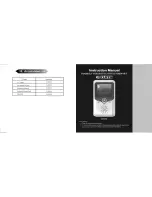
12
|
ni.com
|
PXIe-5673 Calibration Procedure
3.
Connect the PXIe-5450 CLK OUT front panel connector to the PXI-5650/5651/5652 REF
IN/OUT front panel connector.
4.
Connect any available rubidium frequency reference rear panel BNC connector to the
spectrum analyzer REF IN rear panel connector through the BNC(m)-to-BNC(m) cable.
5.
Generate an I/Q tone at -50 MHz offset from the carrier with the following niRFSG
property settings:
•
Frequency (Hz): 200 MHz
•
Power Level (dBm): 0 dBm
•
Generation Mode: Arb Waveform
•
Reference Clock Source: ClkIn
6.
Use the spectrum analyzer to measure the mean output power of the RF output using the
following spectrum analyzer parameter settings:
•
Center frequency: (Frequency in step 5) + (offset in step 5)
•
Reference level: +5 dBm
•
Frequency span: 0 Hz
•
Resolution bandwidth: 500 Hz
•
Sweep time: 5 ms
•
Reference clock source: External
7.
Use the spectrum analyzer to measure the mean output power of image using the following
spectrum analyzer parameter settings:
•
Center frequency: (Frequency in step 5) - (offset in step 5)
•
Reference level: +5 dBm
•
Frequency span: 0 Hz
•
Resolution bandwidth: 500 Hz
•
Sweep time: 5 ms
•
Reference clock source: External
8.
Calculate the ISR according to the following formula and save the values:
ISR
=
Measured Image Power
-
Measured RF Output Power
9.
Repeat steps 5 through 8 for every offset frequency from -50 MHz to +50 MHz in 5 MHz
increments while keeping the LO frequency fixed.
Tip
Set the niRFSG Generation Mode property to
CW
to generate a 0 Hz offset.
The ISR with a 0 Hz frequency offset cannot be measured, and the 0 Hz data point
can be ignored.
10. Calculate the relative modulation bandwidth flatness by subtracting the RF output power
measured at 0 Hz offset from the RF output powers measured at each of the other offset
frequencies.













































